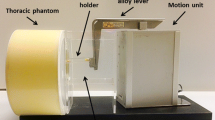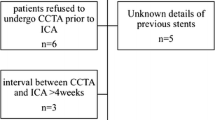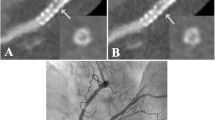Abstract
Objectives
Comparison of coronary artery stent assessment with cardiac CT angiography (cCTA) using traditional filtered back projection (FBP) and sinogram affirmed iterative reconstruction (SAFIRE), in both full- and half-radiation dose image data.
Methods
Dual-source cCTA studies of 37 implanted stents were reconstructed at full- and half-radiation dose with FBP and SAFIRE. Half-dose data were based on projections from one DSCT detector. In-stent noise, signal-to-noise ratio (SNR), and stent-lumen attenuation increase ratio (SAIR) were measured and image quality graded. Stent volumes were measured to gauge severity of beam hardening artefacts.
Results
Full-dose SAFIRE reconstructions were superior to full-dose FBP vis-à-vis in-stent noise (21.2 ± 6.6 vs. 35.7 ± 17.5; P < 0.05), SNR (22.1 ± 8.6 vs. 14.3 ± 6.7; P < 0.05), SAIR (19.6 ± 17.6 vs. 33.4 ± 20.4%; P < 0.05), and image quality (4.2 ± 0.86 vs. 3.5 ± 1.0; P < 0.05). Stent volumes were lower measured with SAFIRE (119.9 ± 53.7 vs. 129.8 ± 65.0 mm3; P > 0.05). Comparing half-dose SAFIRE with full-dose FBP, in-stent noise (26.7 ± 13.0 vs. 35.7 ± 17.5; P < 0.05) and SNR (18.2 ± 6.9 vs. 14.3 ± 6.7; P < 0.05) improved significantly. SAIR (31.6 ± 24.3 vs. 33.4 ± 20.4%; P > 0.05), stent volume (129.6 ± 57.3 vs. 129.8 ± 65.0 mm3; P > 0.05), and image quality (3.5 ± 1.0 vs. 3.7 ± 1.1; P > 0.05) did not differ. Radiation dose decreased from 8.7 ± 5.2 to 4.3 ± 2.6 mSv.
Conclusions
Iterative reconstruction significantly improves imaging of coronary artery stents by CT compared with FBP, even with half-radiation-dose data.
Key Points
• Computed tomography (CT) is becoming an increasingly important investigation for cardiac problems.
• Iterative CT reconstruction techniques significantly improve coronary artery stent evaluation.
• Iterative reconstruction has the potential to reduce radiation dose requirements.
• Improved stent visualisation detects complications better, further reducing the need for catheterisation.





Similar content being viewed by others
References
Kumbhani DJ, Ingelmo CP, Schoenhagen P, Curtin RJ, Flamm SD, Desai MY (2009) Meta-analysis of diagnostic efficacy of 64-slice computed tomography in the evaluation of coronary in-stent restenosis. Am J Cardiol 103:1675–1681
Taylor AJ, Cerqueira M, Hodgson JMB et al (2010) ACCF/SCCT/ACR/AHA/ASE/ASNC/NASCI/SCAI/SCMR 2010 appropriate use criteria for cardiac computed tomography. JACC 56:1864–1894
Andreini D, Pontone G, Bartorelli AL et al (2011) High diagnostic accuracy of prospective ECG-gating 64-slice computed tomography coronary angiography for the detection of in-stent restenosis. Eur Radiol 21:1430–1438
Kerl JM, Schoepf UJ, Vogl TJ et al (2010) In vitro evaluation of metallic coronary artery stents with 64-MDCT using an ECG-gated cardiac phantom: relationship between in-stent visualization, stent type, and heart rate. AJR Am J Roentgenol 194:256–262
Sheth T, Dodd JD, Hoffmann U et al (2007) Coronary stent assessability by 64 slice multi-detector computed tomography. Catheter Cardiovasc Interv 69:933–938
Zhang X, Yang L, Ju H et al (2012) Prevalence and prognosis of coronary stent gap detected by multi-detector CT: a follow-up study. Eur Radiol. doi: 10.1007/s00330-012-2458-6
Sun Z, Almutairi AMD (2010) Diagnostic accuracy of 64 multislice CT angiography in the assessment of coronary in-stent restenosis: a meta-analysis. Eur J Radiol 73:266–273
Gosling O, Loader R, Venables P et al (2010) A comparison of radiation doses between state-of-the-art multislice CT coronary angiography with iterative reconstruction, multislice CT coronary angiography with standard filtered back-projection and invasive diagnostic coronary angiography. Heart 96:922–926
Prakash P, Kalra MK, Ackman JB et al (2010) Diffuse lung disease: CT of the chest with adaptive statistical iterative reconstruction technique. Radiology 256:261–269
Sagara Y, Hara AK, Pavlicek W, Silva AC, Paden RG, Wu Q (2010) Abdominal CT: comparison of low-dose CT with adaptive statistical iterative reconstruction and routine-dose CT with filtered back projection in 53 patients. AJR Am J Roentgenol 195:713–719
Renker M, Nance JW, Schoepf UJ et al (2011) Evaluation of heavily calcified vessels with coronary CT angiography: comparison of iterative and filtered back projection image reconstruction. Radiology 260:390–399
Min JK, Swaminathan RV, Vass M, Gallagher S, Weinsaft JW (2009) High-definition multidetector computed tomography for evaluation of coronary artery stents: comparison to standard-definition 64-detector row computed tomography. J Cardiovasc Comput Tomogr 3:246–251
Moscariello A, Takx RAP, Schoepf UJ et al (2011) Coronary CT angiography: image quality, diagnostic accuracy, and potential for radiation dose reduction using a novel iterative image reconstruction technique-comparison with traditional filtered back projection. Eur Radiol 1:2130–2138
Winklehner A, Karlo C, Puippe G et al (2011) Raw data-based iterative reconstruction in body CTA: evaluation of radiation dose saving potential. Eur Radiol 21:2521–2526
Wolf F, Leschka S, Loewe C et al (2010) Coronary artery stent imaging with 128-slice dual-source CT using high-pitch spiral acquisition in a cardiac phantom: comparison with the sequential and low-pitch spiral mode. Eur Radiol 20:2084–2091
Bongartz G, Golding SJ, Jurik AG et al (2004) European guidelines for multislice computed tomography. European Commission, Brussels. http://www.msct.eu/CT_Quality_Criteria.htm. Accessed 4 April 2012
Yang W-J, Pan Z-L, Zhang H, Pang L-F, Guo Y, Chen K-M (2011) Evaluation of coronary artery in-stent restenosis with prospectively ECG-triggered axial CT angiography versus retrospective technique: a phantom study. Radiol Med 116:189–196
Adlam D, Evans N, Malhotra A et al (2012) Repeat percutaneous coronary revascularization: indications and outcomes in a "real world" cohort. Catheter Cardiovasc Interv. doi:10.1002/ccd.23395
Schuijf JD, Pundziute G, Jukema JW et al (2007) Evaluation of patients with previous coronary stent implantation with 64-section CT. Radiology 245:416–423
Joseph PM, Spital RD (1981) The exponential edge-gradient effect in x-ray computed tomography. Phys Med Biol 26:473–487
Zhang J, Li M, Lu Z, Hang J, Pan J, Sun L (2012) In vivo evaluation of stent patency by 64-slice multidetector CT coronary angiography: shall we do it or not? Int J Cardiovasc Imaging 28:651–658
Van Gompel G, Van Slambrouck K, Defrise M et al (2011) Iterative correction of beam hardening artifacts in CT. Med Phys 38:S36
Gervaise A, Osemont B, Lecocq S et al (2011) CT image quality improvement using adaptive iterative dose reduction with wide-volume acquisition on 320-detector CT. Eur Radiol 22:295–301
Thibault JB, Sauer KD, Bouman CA, Hsieh J (2007) A three-dimensional statistical approach to improved image quality for multislice helical CT. Med Phys 34:4526–4544
Hara AK, Paden RG, Silva AC, Kujak JL, Lawder HJ, Pavlicek W (2009) Iterative reconstruction technique for reducing body radiation dose at CT: feasibility study. AJR Am J Roentgenol 193:764–771
Renker M, Ramachandra A, Schoepf UJ et al (2011) Iterative image reconstruction techniques: applications for cardiac CT. J Cardiovasc Comput Tomogr 5:225–230
Acknowledgements
U.J.S. is a consultant for and receives research support from Bayer-Schering, Bracco, General Electric, Medrad, and Siemens. T.A., S.V., and B.S. are employees of Siemens Healthcare. The other authors have no conflict of interest to disclose.
Author information
Authors and Affiliations
Corresponding author
Rights and permissions
About this article
Cite this article
Ebersberger, U., Tricarico, F., Schoepf, U.J. et al. CT evaluation of coronary artery stents with iterative image reconstruction: improvements in image quality and potential for radiation dose reduction. Eur Radiol 23, 125–132 (2013). https://doi.org/10.1007/s00330-012-2580-5
Received:
Revised:
Accepted:
Published:
Issue Date:
DOI: https://doi.org/10.1007/s00330-012-2580-5




